15 July 1778 Wednesday
. . . . . .
Artifacts of the Bianconi vs Piranesi 'Circus of Caracalla' affair 1772-1789
Giovanni Lodovico Bianconi's "Elogio Storico del Cavaliere Giovanni Battista Piranesi Celebre Antiquario ed Incisore de Roma" (1779)
paragraph five
Non bastò al nostro artefice il primeggiare nell’incisione, che invogliossi di aggiugnere a’ suoi rami dotte descrizioni e ricerche antiquarie, alle quali dovevano servire d’alimento le sue idee spesso peregrine e nuove, e più spesso visionarie. Ma come far questo, se gli mancavano i capitali necessari a tant’uopo, e la cognizione delle due lingue dotte, senza le quali non v’è solida erudizione? Cattivossi egli destramente vari insigni letterati, i quali, innamorati del suo ingegno e del suo bulino, non isdegnarono di lavorare per lui, componendo insigni trattati corrispondenti a sì bei rami, ed ebbero la generosità di permetterglielo sino che li pubblicasse col suo nome. Non si dubiti di mettere in tale numero Monsignor Bottari, il dotto Padre Contucci Gesuita e vari altri, che crediamo inutile di qui nominare. Vedeva dunque Roma uscire di tempo in tempo volumi atlantici di stampe e di dissertazioni dottissime col nome di chi appena era in istato di leggerle, benché potesse poi renderne buon conto, ma alla sua maniera, a chi gliene parlava. Con quasi tutti questi letterati disgustavasi però alla lunga il Piranesi, ora per la sua naturale intolleranza e rozzezza, ed ora perché non volevano quei dotti scrittori adottare le sue stravaganti visioni. Arrivò finalmente il Piranesi a persuadersi che erano opera interamente sua que’ libri che per lui avevano composti tante illustri penne, e guai se alcuno non glielo avesse accordato, non eccettuando qui neppur gli autori medesimi. Il solo che lo abbia tenuto mai sempre a freno sino alla morte è stato il nobilissimo Monsignor Riminaldi auditor di Rota. Questi, a guisa di Nettuno, che con un colpo di tridente fa tacere Eolo e i venti, colla sua erudizione e moderatezza avea preso tal possesso sopra di lui, che quando egli alzava la voce, il Piranesi tosto s’ammutoliva. Non v’è uomo per quanto sia feroce e potente, che non abbia in questo mondo il suo dominatore, a cui non può in verun modo resistere. Un uomo divenuto sì celebre dovea avere luogo nella nostra Accademia di S. Luca. Fu pertanto aggregato a quest’illustre corpo l’anno 1761; ma qui pure portò il Piranesi la discordia. Trovò egli nelle stanze dell’accademia una lite assai seria con un architetto, il quale non parlava dell’arte a modo suo, e vennero alle mani, ma fu ben presto sopito dai coaccademici tanto nascente incendio.
It was not enough for our craftsman to excel in engraving, who wanted to add learned descriptions and antiquarian research to his branches, to which his often strange and new, and more often visionary, ideas were to serve as nourishment. But how to do this, if he lacked the necessary capital for such a purpose, and the knowledge of the two learned languages, without which there is no solid erudition? He dexterously defied various distinguished men of letters, who, in love with his genius and his burin, did not disdain to work for him, composing famous treatises corresponding to such beautiful branches, and they had the generosity to allow him until he published them under his name. Do not hesitate to include in this number Monsignor Bottari, the learned Jesuit Father Contucci and various others, whom we deem useless to name here. From time to time, therefore, he saw Rome release Atlantic volumes of highly learned prints and dissertations with the names of those who were barely able to read them, although they could then give a good account of them, but in their own way, to those who spoke to them. In the long run, however, Piranesi was disgusted with almost all these men of letters, now because of his natural intolerance and rudeness, and now because those learned writers did not want to adopt his extravagant visions. Piranesi finally arrived to persuade himself that those books which for him had composed so many illustrious pens were entirely his work, and woe to you if anyone did not grant it to him, not excluding here not even the authors themselves. The only one who ever kept him in check until his death was the very noble Monsignor Riminaldi auditor of Rota. Like Neptune, who with a stroke of his trident silences Aeolus and the winds, with his erudition and moderation had gained such possession over him that when he raised his voice, Piranesi immediately fell silent. There is no man, however ferocious and powerful, who does not have his ruler in this world, whom he cannot in any way resist. A man who became so famous had to take place in our Academy of S. Luca. It was therefore aggregated to this illustrious body in the year 1761; but here too Piranesi brought discord. In the rooms of the academy he found a very serious quarrel with an architect, who did not speak of art in his own way, and they came to blows, but the nascent fire was soon put to sleep by the co-academics.
paragraph six
Con quest’auge di fama la santa memoria di Clemente XIII volle decorarlo della croce equestre, che i Papi sogliono accordare agli artefici più insigni, e farli altre grazie, che non poco lo incoraggirono. Gli fu data la commissione di fare un disegno per rimodernare la Chiesa dell’ordine di Malta sull’Aventino chiamata il Priorato. Riuscì questo assai vago e bizzarro, e si determinò da chi aveva a cuore l’abbellimento di quel tempio di metterlo in esecuzione, lo che si fece con magnanima e principesca spesa. Oh quanto è diverso “il disegnar dall’eseguir le imprese!”.
With this growth of fame, the holy memory of Clement XIII wanted to decorate him with the equestrian cross, which the Popes usually grant to the most illustrious craftsmen, and to grant him other graces, which encouraged him not a little. He was given the commission to make a design to modernize the Order of Malta's church on the Aventine called the Priory. This turned out to be very vague and bizarre, and it was decided by those who had the embellishment of that temple at heart to put it into execution, which was done with magnanimity and princely expense. Oh how different is "drawing from executing businesses!".
46 y.o. Francesco Piranesi 1804
Le Antichità della Magna Grecia Parte I
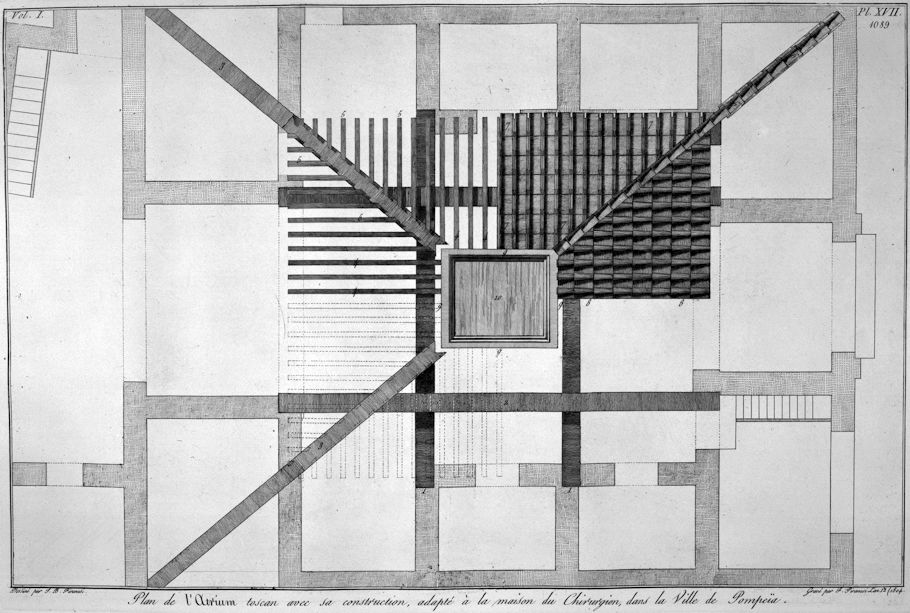
Plan of the Tuscan Atrium with its construction, adapted to the house of the Surgeon, in the City of Pompeii.
Drawn by G.B. Piranesi
Engraved by F. Piranesi Year 12 (1804)
15 July 1812 Wednesday
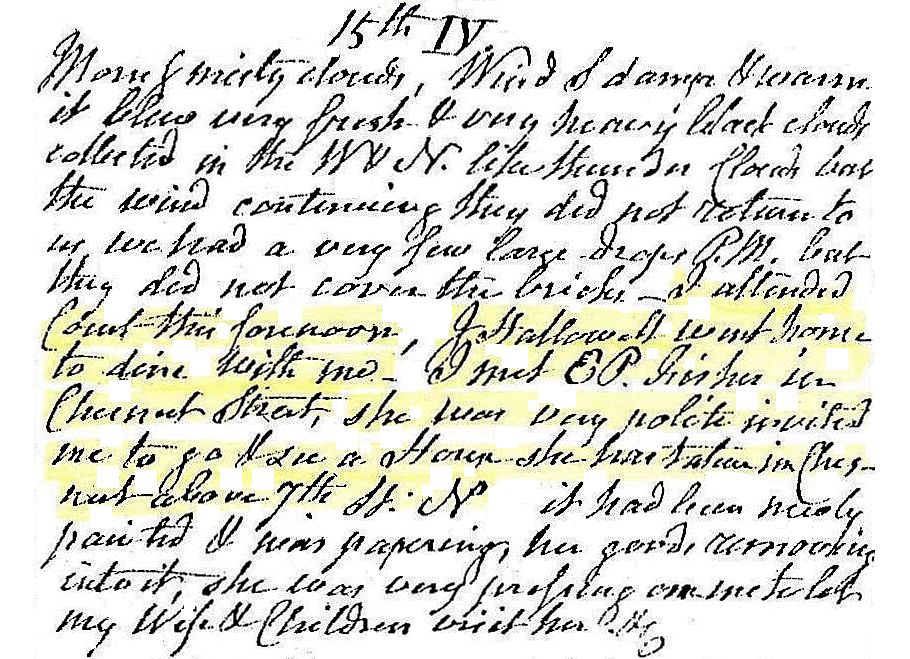
Morning misty clouds, wind S damp and warm. It blew very fresh and very heavy black clouds collected in the W and N, like thunder clouds, but the wind continued. They did not return to us; we had a very few large drops PM, but they did not cover the bricks.
I attended Court this forenoon. J Hallowell went home to dine with me.
I net EP Fisher in Chestnut Street. She was very polite, invited me to go and see a house she had taken in Chestnut above 7th Street N. It had been nicely painted and was papering; her goods removing into it. She was very pressing on me to let my wife and children visit her, etc.
15 July 1996
new insights - key to the language of plans
...a substantial key concerning the language of the plans within the Campo Marzio.
The key to the language of plan forms starts with the long 'spiritual' axis of Mars and the tiny temple/shrine to the union of Mars and Rhea Silvia. I will not here go into the whole story of the long axis except to say that the Mars/Rhea Silvia shrine at the very end of the axis is the very basis of all the Piranesi plan forms. The plan of the shrine itself depicts, in simple planimetric form, the union of the male sex organ with the female sex organ. The plan is plain and simple, and, were it not for its small size, would also be perceived as vulgar and blunt. Yet there is an essential beauty in its fertile simplicity--the notion of elementary plan forms is enhanced a thousand fold by the symbolism of outside vs. inside--gives it the power to spawn every other plan formation delineated.
The power and significance of the small shrine plan comes to the fore after an analysis of the second significant axis of the Campo Marzio--the Equiria. This axis represents the war/military aspect of Mars, and, when compared with the long axis running through the altar to Mars, the Equiria, the race course, can be clearly considered the mundane axis (as opposed to the spiritual or sacred axis). The military character of the axis is quickly reinforced by the military offices and the military parade grounds that lie to the northern end of the Equiria. The fact that the Equiria is a horse race course also reinforces the mundane/military character of the axis, and this mundane aspect is most clearly manifest with the dirt road reality of the axis itself. (There may be the opportunity to call out a sacred vs. profane contrast between the two axes.)
Seeing how the first axis ends in sex, I was curious to see if the Equiria axis also ends in sex. While there is no building plan that explicitly depicts the co-joining of sexual organs, the north end of the axis has a pair of simple buildings--Vivaria Fulvii and Cochlearum Hirpini--made up of very few contiguous elements. I think this type of plan is the next step in the hierarchy after the sex temple. It is almost as if the sex temple starts something that quickly multiplies and mutates in the process. These two plans next to each other demonstrate the high order of symbolism in the first.
From the second order of plan, the next step up in the hierarchy is best exemplified by the Gymnasium on the Tiber and the Villa Publicus where the contiguous elements are still few yet numerously repeated, however there is a substantial addition of articulation in the individual contiguous pieces, especially in the carving out of space in the form of niches and thus heightening the issues of outside/inside, solid/void, figure/ground. This third type of plan formation is much more strongly related to the sex temple, yet the lesson of the second type of plan, the gemmation of a few parts, is a vital step in the evolutionary development of the plans. An embryonic development of plan configuration?
15 July 2006
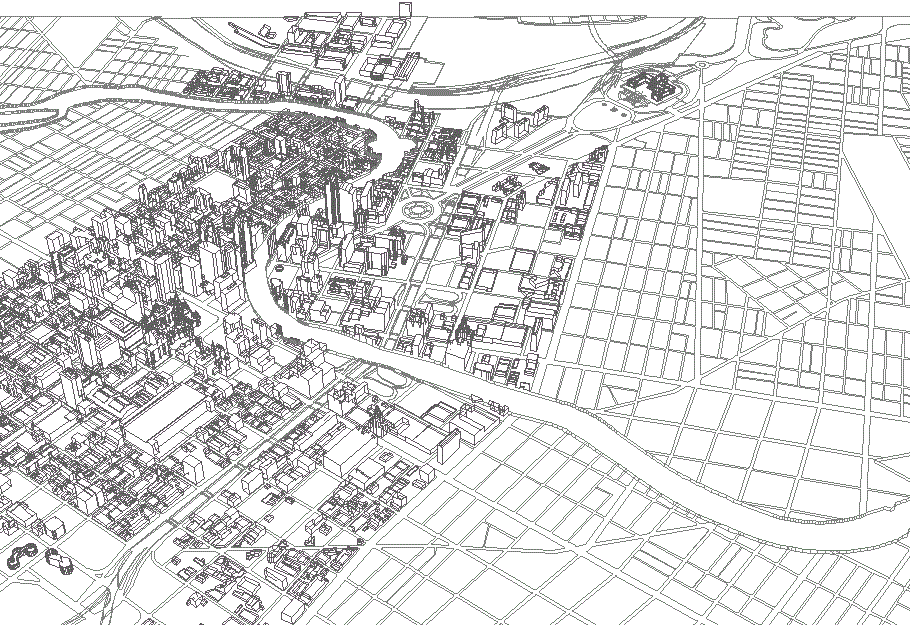
Romaphilia perspective
15 July 2008
bored with modern & contemporary, yet?
...there really is no evidence that Michelangelo knew the rules so well that he thus also knew best how to break them. That logic is more indicative of a latter-day, wishful-thinking, pedagogical explanation.
Michelangelo was more of a reluctant architect; architectural commissions were generally not something he sought. Sculpture was his real passion, and I suspect it was his sculptor's eye that really led him to use/design architectural molding the way he did.
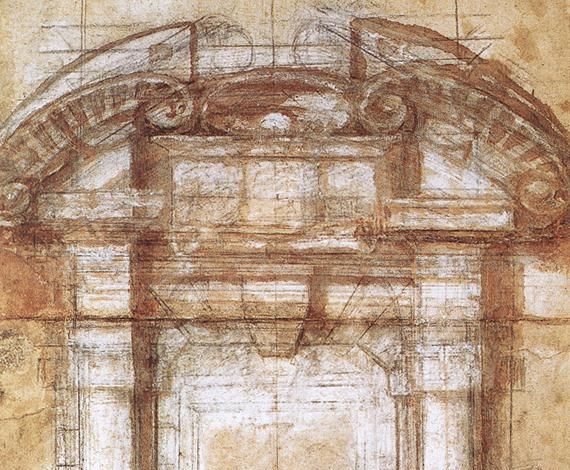
bored with modern & contemporary, yet?
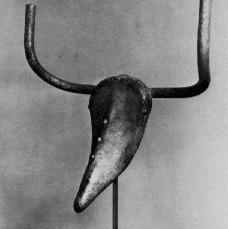
Picasso wasn't necessarily breaking any rules here, but he was being somewhat improper. What this work tells me is that Picasso recognized a sculptural potential in a bicycle seat and handle that when combined (improperly, in a way not done before) generated a masterpiece. I get the same sense when I look at Michelangelo's architectural detailing. Rather than simply breaking the rules, he saw potential in architectural details that others before him hadn't seen before, and he produced many improper combinations and many unprecedented details, e.g., Porta Pia.
Perhaps Michelangelo didn't even see classical architecture as a set of rules, rather a set of potentials. (And perhaps language/grammar too might not be seen as a set of rules, but rather a set of potentials).
15 July 2021
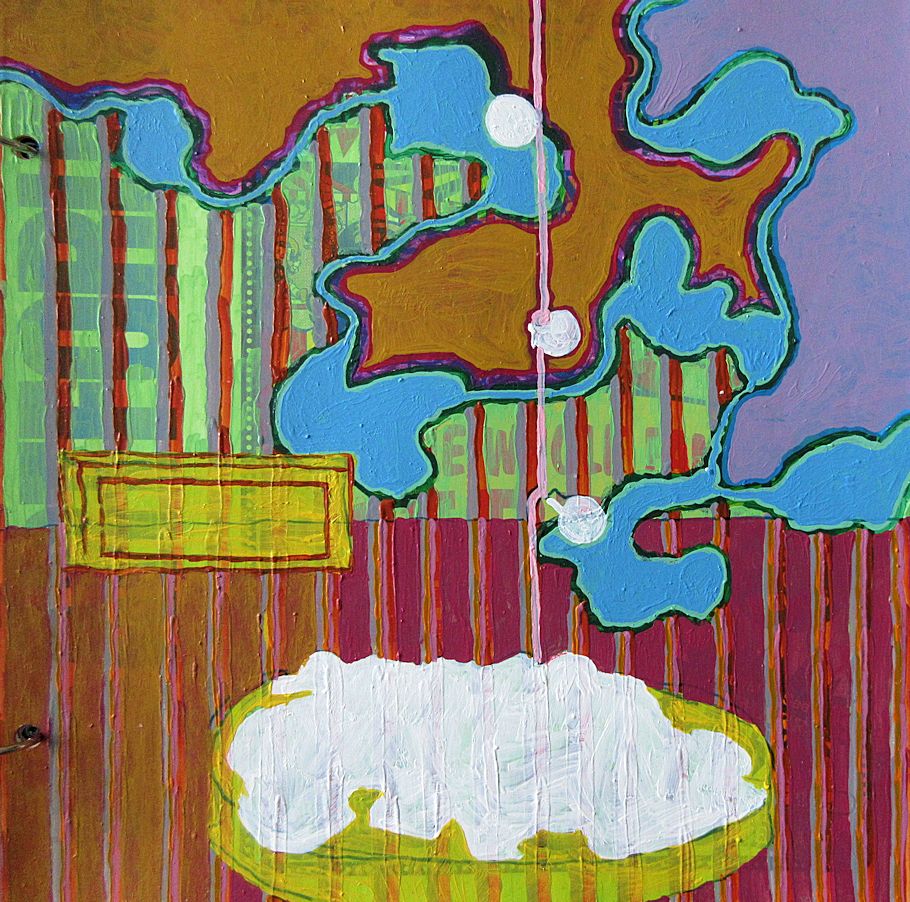
15 July 2023 Saturday
episode four: "The Peace of the Pie"
"The Time Peace of Humanity" now supersedes "My connection to Russia, ultimately."
23 April 2023
RE: Hello Yura, from Stephen Lauf
Hello Yura,
The quick answer to your request for permission is a respectful and cooperative yes! I’m most interested to see how you will be using/interpreting “The Timepiece of Humanity.”
I would also like, however, to use our cooperation as a project of opportunity for me to ‘artistically’ express my reaction to being part of “Stellar Revenge.”
I still have to compose my ideas, which I hope to send to you within the coming week, but I can start with the following anecdote:
Although I had no name for it at the time, the theory of chronosomatics first occurred to me in 1981, when I was living and working in Washington DC for the summer. It was not till years later that I first read the phrase “a timepiece of humanity” within a translated excerpt from Velimir Khlebnikov’s The Tables of Destiny published in October 27. It immediately occurred to me that I too have been thinking about and formulating a “timepiece of humanity,” and that’s when I began to write my ideas down.
While I’m collecting my thoughts, I would greatly appreciate your telling me more about “Stellar Revenge.”
I’m so happy and grateful that you contacted me, and, although the thought never occurred to me before, it feels to be perfect that The Timepiece of Humanity/theory of chronosomatics will be, for the first time anywhere, formally presented in Russia.
Yours truly,
Steve
episode five: "Nowadays they call it 'going out on a détente'"
|